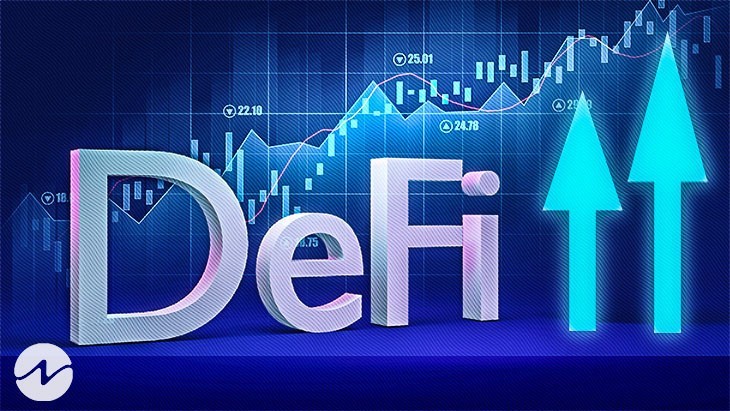Rise of Decentralized Finance (DeFi) And Its Impact on Traditional Finance

New technologies constantly change the landscape of business finance. Startup Decentralized Finance (DeFi) marketplaces are the next step in the evolution of entrepreneurial finance. The term “Decentralized Finance,” also known as “Distributed Finance” or “Open Finance,” refers to a financial business environment without a single governing authority.
DeFi is a brand-new idea or an expansion of the application scope of blockchain or distributed ledger technologies (DLT) as infrastructure, even though ideas like distributed and decentralized computing have been around for decades.
Decentralized finance, that utilizes distributed systems and smart contracts instead of traditional financial institutions, has many advantages over more established financial services. Deploying a financial application or product becomes much less difficult and demanding as networks get older.
From a DLT and Blockchain standpoint, one of its biggest claims and value-drivers is the idea that it permits decentralized peer-to-peer transactions without the need for a third-party intermediary and their associated fees. DeFi has the potential to open up novel methods for access to services and endeavors like payments, loans, borrowing, funding, and investing by integrating this technology into the established financial system.
There Are Three Major Functions in DeFi :
- Monetary finance services translation
- Providing peer-to-peer lending and borrowing platforms
- Enabling advanced financial tools like Decentralized Exchanges (DEXes), Tokenization Platforms, Derivatives and Predictions Markets.
Let’s Explore the Causes of the Rise in DeFi and How It Affects Traditional Finance
Traditional finance has always depended heavily on intermediaries, such as banks, insurance companies, and stock exchanges. Moreover, it has been subject to stringent regulation as a result. Regular consumers must deal with a variety of financial intermediaries for their operational requirements and day-to-day operations in order to access everything from loans and mortgages to trading stocks and bonds. Therefore, they are subject to stringent laws and regulations.
DeFi use cases provide a number of advantages and may eliminate some of the shortcomings of the traditional financial ecosystem. In order to centralize tasks and financial resources, traditional finance is define by large intermediaries. The idea of finance and financial centers as hubs and spokes is the result of this. Today traditional banking is characterized by both technology and globalization.
Thus, market-based financial systems are frequently seen as inherently unstable. Instability and other types of market failures are addresses by regulation, though never completely effective.
DeFi is an aspect of fintech because it combines innovative technology with the aim of upgrading client services. And enhancing the financial sector as a whole. It can be characterize as the execution of financial smart contracts, protocols, and dAPPs on blockchains and DLTs with the aim of transforming the way that dealing, lending, and banking are conducted.
There Are Two Major Categories of Development in the Area of Decentralized Finance:
- First are techniques that intentionally give people more power by creating goods that make it easier for them to interact with decentralized systems like payments, trading, or lending.
- The other part is working to integrate traditional systems while creating alluring goods and services that alter perceptions by integrating effective and efficient blockchain-based solutions into their business practices.
Lending services and derivatives actually fill the functions of commercial, retail, and investment banks. Decentralized exchanges fill the roles of stock exchanges, financial asset exchanges, and brokers from a traditional financial viewpoint.
Role of Smart Contracts in DeFi
Smart contracts control the contracts and deals that are an element of DeFi services.
DeFi applications don’t need intermediaries or mediators. Because the code outlines how to settle every conceivable conflict and users always retain control over their money. This reduces the price of providing and using these goods and makes it possible for a more frictionless financial system.
Smart contracts are self-sufficient. Once they are signed, the parties involved are only bound by the conditions they agreed to, and not by any other external authority. Because of this characteristic, contractual agreements are also more secure and safe because they cannot be manipulat by either side.
Smart contracts have been the highest form of blockchain technology application since its beginnings. The potential for smart contracts to completely reimagine the company and the financial sector is unbounded when combined with their autonomous strength, speed, and transparency.
And also one of the most popular categories of applications in the DeFi ecosystem are open borrowing and lending protocols. Instant transaction settlements, the ability to use digital assets as collateral, the lack of credit checks, and the potential for future standardization are just a few of the many benefits these novel implementations have over the conventional credit system.
Blockchain-based lending platforms lower counterparty risk while raising the speed, efficiency, and usability of borrowing and lending. For market players, the platforms and protocols for lending and borrowing offer a number of advantages. For example, An asset can be shorted by a borrower who acquires it and then sells it right away for another crypto coin on any other market. This mimics margin trading on centralized exchanges and also gives margin trading capability on platforms without it.
Conclusion
DeFi addresses an important challenge by utilizing Blockchain in its normal operations. Users are now capable of obtaining funds while also doing so in an open and transparent way. That helping people who are underbanked, debanked, or totally unbanked. We’re seeing mainly the reapplication of the majority of the traditional financial services. Including borrowing, lending, saving, trading in derivatives and futures, as well as different types of currency pegs.
Despite being implement in novel methods, they basically serve the same purposes. As technology develops, this will change accordingly.






 Bitcoin
Bitcoin  Ethereum
Ethereum  Tether
Tether  USDC
USDC  TRON
TRON  Dogecoin
Dogecoin  Cardano
Cardano  Bitcoin Cash
Bitcoin Cash  Chainlink
Chainlink  LEO Token
LEO Token  Monero
Monero  Stellar
Stellar  Zcash
Zcash  Litecoin
Litecoin  Hedera
Hedera  Dai
Dai  Cronos
Cronos  Tether Gold
Tether Gold  OKB
OKB  Ethereum Classic
Ethereum Classic  KuCoin
KuCoin  Cosmos Hub
Cosmos Hub  Gate
Gate  Algorand
Algorand  VeChain
VeChain  Stacks
Stacks  Tezos
Tezos  TrueUSD
TrueUSD  Dash
Dash  IOTA
IOTA  Basic Attention
Basic Attention  Theta Network
Theta Network  Decred
Decred  NEO
NEO  Synthetix
Synthetix  Qtum
Qtum  Ravencoin
Ravencoin  0x Protocol
0x Protocol  DigiByte
DigiByte  Zilliqa
Zilliqa  Nano
Nano  Siacoin
Siacoin  Numeraire
Numeraire  Waves
Waves  Status
Status  Ontology
Ontology  Enjin Coin
Enjin Coin  BUSD
BUSD  Hive
Hive  Pax Dollar
Pax Dollar  Lisk
Lisk  Steem
Steem  Huobi
Huobi  Bitcoin Gold
Bitcoin Gold  OMG Network
OMG Network  NEM
NEM  Augur
Augur  Bitcoin Diamond
Bitcoin Diamond